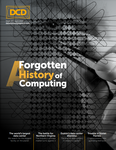For all their early endeavours and innovation, technological pioneers generally pave the way for others to follow but rarely remain at the forefront of further advancement.
The succession of high-profile withdrawals from the data center infrastructure management (DCIM) market are testament to this trend. While once prevalent and considered revolutionary, platforms such as Aperture and Trellis have been consigned to the cyber scrapheap – discontinued having reached their Betamax moment.
There are myriad reasons for the mothballing of such systems but chief among them is that data centers have evolved at pace and the tools once regarded as “hi-tech” have proved unfit for purpose, becoming the sector’s equivalent of VHS in the streaming era.
Left behind
Charged with the management of increasingly complex and expansive facilities, the DCIMs of yesteryear simply do not have the next-generation nous to comprehensively grasp the entirety of a data centers environment and the contribution each component within it makes to performance and optimisation.
With limited management and automation capabilities, they have long been consigned to the role of needlessly elaborate asset registers, which rarely contain accurate or up to date information.
The demise of dated DCIMs has not, however, diminished the need for a comprehensive management tool. Far from it, in fact. Now more than ever, data center owners require orchestration and optimisation of services and resources to deliver profitable and sustainable operations.
To do so, solutions should provide comprehensive integration with a broad diversity of devices and specialist software systems and bridge the gaps between a facility’s grey and white space.
In brief, it is no longer an option to dwell in the data center Dark Ages and those still running antiquated apps or relying on spreadsheets for monitoring and informing provisioning need to migrate to the modern day to futureproof their services and information.
I believe the path to tomorrow’s world is dependent on DCIM evolving to become Universal Intelligent Infrastructure Management (UIIM).
Get universal
Such an approach would deliver a technologically-agnostic solution that integrates and interrogates its surroundings – no matter how expansive – to retrieve both historical and current information from physical assets and legacy systems and paint a comprehensive picture of a data center’s topology.
Once equipped with this universal understanding of a facility, be it an enterprise, edge, colocation or geographically dispersed set-up, UIIM will be empowered to impart its intellect and could be relied on to provide a federated, real-time view of operations.
Aside from navigating away from any network crashes and unnecessary downtime, this single source of truth of everything from asset availability and resource utilisation to connectivity and the health of IT components can guide operators towards optimal performance.
UIIM’s true value, however, would lie in its ability to read the road ahead, with advanced algorithms determining provisioning for new assets at speed; assessing the risks and rewards of strategic decisions and major network changes; and producing automated work orders that signpost engineers directly to their required destinations.
A next-generation approach to a long-standing requirement, UIIM would be the data center equivalent of ditching DOS and downloading Microsoft or Apple’s latest operating system.





